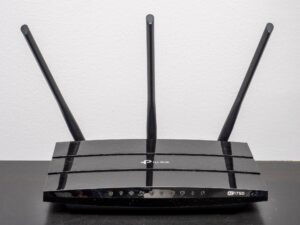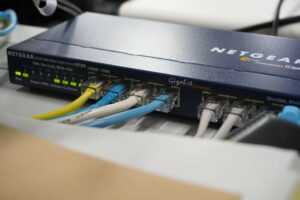Hopping on your browser, streaming movies, games, music, and more seamlessly via Wi-Fi or the internet seems easy, right? Well, yes, it is when you have a network that is equipped with must-have devices.
Modems, routers, and switches are some of the most common elements of a networking system. But how can you differentiate between these, especially if you aren’t a techie? Worry not! We got you. In this article, we have mapped out the distinction between modem vs. router vs. switch and given insight into their features.
No products found.
With that being said, let’s get started.
What is a Modem?
If you want your network to be linked to the internet, you should consider getting a modem, as these devices allow you access to the web. The modulator-demodulator, more commonly known as a modem, provides you with a seamless internet experience with the help of an Internet Service Provider (ISP).
Moreover, this gadget helps convert the 1s and 0s from your laptop or computer into analog data, then transfers it to your network via telephone cable lines. You can even connect this device to a router or an ethernet cable; this allows your computer/laptop to be linked to the internet.
Advantages:
- Signal conversions that help your device in connecting to an ISP
- Provides you with excellent transmission speed, which is great for enhancing your efficiency.
- The automated dialing features integrated into this device make communication better as you can operate on the commands of external computers as well.
- Moreover, this device’s fax technology helps send and receive messages via modem.
Disadvantages:
- The major drawback of this device is its vulnerability to viruses, hackers, and other malware activities. However, few devices come with a built-in firewall for better security.
- The cost of getting and setting up this device can be expensive, mainly due to hardware and other elements.
- Modem solely cannot handle the heavy traffic of both the LAN and the internet.
- This device requires high power to function, and the connection can slow down due to heavy data exchange.
What is a Router?

Have you ever wondered how all your gadgets in a network link to the modem or Wi-Fi? Well, that’s exactly what a router does. This device enables your computer, printer, laptop, and other smart devices to exchange files/data over the same network.
Usually, you get a router when you intend to exchange a heavy load of information via your modem. The router helps send/receive data from the modem to the connected devices.
The NAT or the Network Address Translation system allows access to all the linked-to devices by entering a private IP address. This makes your network authentic and ensures there is no external threat to your files or the gadgets linked to the router via a wired connection or wirelessly.
Along with this, the built-in firewall integrated into most routers guarantees your network is protected from malware/anonymous traffic.
Advantages:
- Improves and strengthens the connectivity of all the linked devices and the quality of streaming media.
- The router in your networking system provides you with excellent security as it can be used as a mediator between networks, diminishing the attacks of any malware or trojan in your system.
- The packet filtering technology of this device further ensures your safety and protection of the connected devices.
- The backup integrated into this device prevents any data from getting lost if there is an error in transmission.
- NAT ensures smooth performance, especially in a high-trafficking network.
Disadvantages:
- The speed of a router can eventually slow down as the data is thoroughly examined from the physical to the network layer, which takes an extended period.
- Setting up a router in your space can be tricky, so it is better to take professional help with it to avoid any future complications.
- Network congestion and routing tables can lead to a large amount of bandwidth consumption.
What is a Switch?

Undoubtedly, a network is formed by connecting multiple devices, which can create congestion and degrade the overall performance. A switch is used to provide more ports to the router so that everything can function to its full potential. Most people make a common mistake by assuming switch and hub are the same devices.
However, the devices handle loads of data each in the network by ensuring that no one device takes too much load. It also assures that the data is distributed and transferred solely to the necessary device. This device further improves the network by equipping it with high security as well as enhancing its capabilities.
Advantages:
- A switch helps increase the bandwidth of the network.
- These devices decrease the data load by ensuring that information is solely transferred to a specific device.
- The smart distribution of data boosts the overall capacity and operation of the network.
- Switches create collision domains for all the connected devices so that the switches’ networks experience fewer frame collisions.
- You can even directly connect this to any of your devices like a computer, laptop, etc.
Disadvantages:
- It can be hard to spot network/connectivity issues with a switch installed in your system.
- The overall cost of the installation of this device is expensive.
- Switches can be exposed to various malware threats.
- There can be a hassle due to broadcast traffic.
- Proper design and configuration are needed to handle multicast packets.
Difference Between Modem, Router, and Switch
This section will compare the functions of modems, routers, and switch to understand the primary role each of these devices plays in making your networking system better.
Also, knowing the distinction will help you figure out what you need to elevate your experience.
Modem Vs. Router
Both of these products are often confused with being the same device; however, their features vary extensively. A modem is a hardware device used to connect your computer to the internet via cable wires, optical fiber lines, and more. This device translates digital signals into analog signals in the form of zeros and ones that help your devices be linked to the ISP.
Data from the local internet service provider is transferred to your device via modem, which operates at the OSI model’s data-link layer 2.
On the other hand, Routers help expand the network range and even connect to Wi-Fi. The router acts as a central device for sharing files and data and connecting all the small or large devices in the network. The Wi-Fi router ensures there is minimal traffic congestion by creating various pathways for the information to flow. It can also join several networks following the same process.
Data packets are used in routers to share data and files to the local network via the quickest pathway. This device works on OSI layer 3.
Apart from this, modem and router can work together to give a speedy internet connection. The data is continuously exchanged with the help of cable wires installed in these devices, making sure your network is connected to the internet.
Various products are available in the market that are integrated with both modem and router in a single device. The combination of both devices is ideal for large offices and workspaces.
Router Vs. Switch
Next up are the router and switch, both of these save the hassle of high data trafficking, but they still have some key differences. Generally, various devices are working simultaneously in a network, which can cause an extensive load on the system. So, installing a switch in your networking system ensures smooth functioning.
The primary role of a switch is to communicate information with only the required device, which prevents losing any data in the process of transmission. The switch works on the OSI model’s data-link layer 3.
The router transmits data among different networks to merge them, but the switch helps you target a device/network that requires specific data.
To put it more simply, your local ISP brings the internet to your home, making connections with other networks using the router with a specific IP address. On the other hand, the switch has nothing to do with other networks; it only allows the incoming and outgoing data to be shared among devices, which occurs inside your network.
Modem Vs. Switch
As you already know, a modem connects the devices in a network to the internet, while the primary feature of a switch is to ensure the network is not overloaded with data.
Of course, both of these devices are very different, but they play an essential role in your networking system as a modem makes your work more efficient, and the switch gets you a secure line to do all the work.
Frequently Asked Questions
1. Can a Router be Used as a Switch?
Yes, you can configure your router to act as a switch by altering the settings. Many office routers are a collection of multiple network devices. You can use it for other tasks when routing features aren’t requested or required.
2. Do I Need a Modem With a Router?
Yes, you need a modem and an internet service provider (ISP) if you want to access the internet. However, you can use a router without a modem if you are just looking for a medium to transfer files or stream data on a wireless network.
3. Can I Get Internet Without a Modem?
For seamless access to the internet, you need both a modem and an internet service provider (ISP).
Although you can connect your computer, laptop, and other devices to the modem directly using an ethernet wire cable, you should go for a router if you want a smooth wireless connection.
4. Can I Get the Internet With Just a Router?
You can’t connect to the internet with simply a router unless it contains a built-in modem. A router just shares information or data packets to several devices linked in a network, but it does not establish any new internet connection.
5. Do You Need Fiber With a Modem?
If you want to use fiber optic internet, you need a brand new modem and fiber optic cables that can be set up/connected in your home. Nowadays, Most telecommunications companies are offering what’s called fiber-to-home service.
6. What is the Difference Between The Modem, Router, And Switch?
There are several differences between these devices, but the basic factor is that you need a modem to connect to the internet, whereas a router is located between a modem and a switch or hub that serves as a gateway to the computer network. A switch links devices to the router, such as a desktop, laptop, and access point.
7. Why are Routers Slower Than a Switch?
Routers connect numerous networks. A routing table is created as a result of this, and it is responsible for storing information on various available networks and locations.
Routers can be slower than switches on a LAN because they must decide whether or not to transfer packet data to the correct destination.
Wrapping Up
There you have it, a well-researched comparison of three primary networking devices; modem, router, and switch. Although, as you can see, all these devices share some similarities and work to make your network better, they still differ in functions.
A modem is used for you to have seamless access to the internet. However, the router connects various devices to the modem, and the switch provides you with extra space for additional devices while also handling the data traffic.
Along with this, you should also consider the pros and cons of each of these devices so that you can set up an effective network.
I hope this article was helpful for you to spot the distinction and features of these networking devices. Happy reading!



